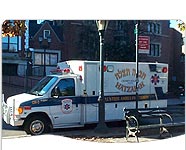 
Scalp Wounds Can Be Closed with a Twist of the Hair and a Dab of Glue
A study finds closing suitable scalp lacerations with the hair apposition technique (HAT) compared to standard suturing is a faster, less painful, and inexpensive procedure that has fewer complications.
In the United States, more than 12 million traumatic wounds are treated in emergency departments every year, according to the article. Traditionally, these wounds are cleaned and then sutured, which patients perceive to be a slow and painful method. Sometimes the hair around the wound is shaved and a bald patch results. Patients also must return to a physician's office to have sutures removed.
The HAT technique requires physicians to choose 4 or 5 strands of the patient's hair on either side of the scalp laceration, crossing the strands with a single twist to close the wound, and securing the twisted strands with a drop of glue.
The HAT group's wounds tended to heal faster, experienced less scarring (6.3 percent versus 20.4 percent) and had fewer overall complications (7.3 percent versus 21.5 percent), significantly lower pain scores (median 2 versus 4), and shorter procedure times (median 5 versus 15 minutes). In addition, there was less wound breakdown in the HAT group (0 percent versus 4.3 percent). When patients were asked if they were willing to have HAT performed in the future, 84 percent responded yes.
This simple and inexpensive method of closing a scalp wound is also faster and reduces the pain associated with traditional methods. In addition to these advantages, this procedure eliminates the need for a follow-up exam to remove a device, there is no risk of needle sticks, and the patient does not require hair removal.
Despite the many advantages, the HAT method has some potential downsides. This method only joins the outermost layers of the skin, which could lead to the wound breaking open again, possible infection, wide scars, or hematoma formation. HAT also does not stop bleeding and should not be used for bleeding wounds.
Source: Annals of Emergency Medicine, July 2002.
The above is for general informational purposes only. Always consult your
physician regarding specific medical issues and call Hatzalah or your local
ambulance service in the event of an emergency.
Back to Digest Index
|









